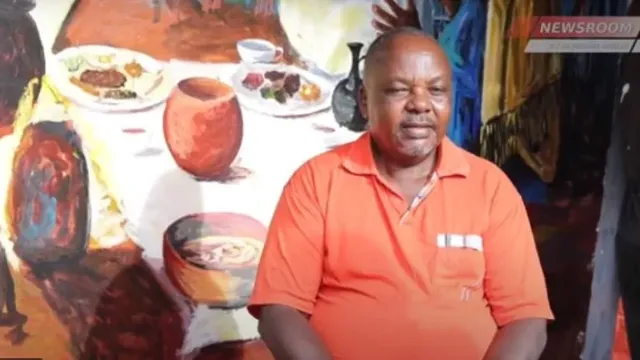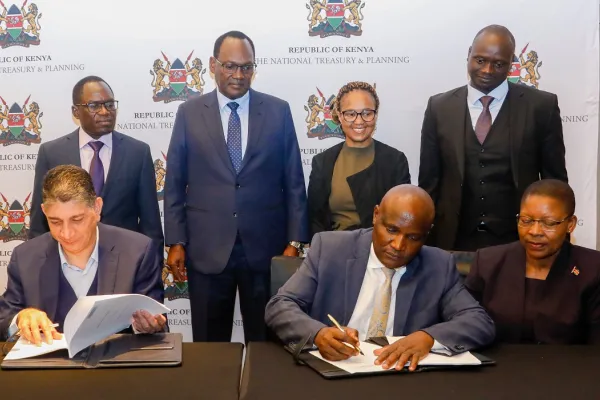Kateete’s portraits of history of tribes

Kateete’s portraits of history of tribes
Getting to Leonard Kateete’s home was not going to be easy with the legendary Rongai traffic woes. He had sounded amused that I would make the trip as if he was used to such games with every of his first time visitors.
I had called him from a reference of a friend who understood our project and felt Mr Kateete fit the description of what we were looking for. He had been too busy but then he called back. I was doing another story so I mixed him up.
“I am doing a story around the dollar...” and he let me go on to tell him about this other story and when I was about to ask my question he told me I had him confused, he was an artist. He asked who might have introduced me to him, I said a friend from Marsabit they had met by chance when he was painting shrines. How did I want to do the interview? I said I would go to his home, and he said he lived in Karen View. I said I would find myself there if he would be so kind to drop me a Google pin on WhatsApp. He was amused on the other side and I would later learn he was not strong on technology. He repeated that he lived somewhere near Karen View, which was actually Rongai but I promised to go.
As we skirted through the legendary diaspora traffic with a mini game drive through the thickets of Nairobi’s wealthy Karen neighbourhood heralded through gates that checked, we did not have the beards of some famous land grabbers. We headed to the cluster of unplanned Rongai neighborhood. Now this place is a complete maze of narrow, unmarked dirt roads that cut around houses and those near fifty-by-a-hundred plots. Each turn buries you deeper and your biggest worry is a car approaching from the opposite side because there is no way you can give way.
Good thing our photographer is from Rongai. So I handed over Mr Kateete to abler hands. After conferring, he said he knows the place. In fact, he used to leave just around the area, a fancy neighbourhood which was in sharp contrast of the squat he lived in at the time. Actually that was the exact spot he learned from the best about safety on city estates after getting mugged one day. So we followed the traumatic memory of a robbery to Mr Kateete’s door.
One foot into his door and our eyes were quickly stolen by a huge moor of camels, their mouths mulching from side to side, the gravel beneath their feet so real and there was salt in the hot humid dust that rose against a blue sky. It was almost real.
Mr Kateete has been doing these murals from Kenya's North, he comments as he follows our awe across to goats grazing on pebbled ground stretching further away from a herder. He then points us to another piece of cacti, thin-leaved spiky native to Chalbi desert, a harsh and very remote environment East of Lake Turkana.
Read also: We may not pay top dollar, but sisi ndio tuko
We close our gaping mouths enough to remember why we are here. We heard that he has painted portraits of old people from 32 East Africa tribes since 1992 and wanted to hear his story. He brought out a laptop wrapped in polythene like he had been advised about the risk of dust.
He powered it on and its blank screen with just a few utility folders on the desktop powered on. He turned to me and said he did not know much about technology. That I would find the photos on the folder.
I clicked them on and immediately there came an almost life like old man and woman with these huge impressionable feet and detail on their skin it almost felt like he was painting humans. If our jaws did not drop it was because frame after frame meant that our mouths remained open with wonder as he gave us intimate commentary of where each of the old men sat for him, their names, and sometimes the names of their grandchildren.
Soon it was turn of the Suba and NyarSindo was so amazed that her people had made the cut, dried into caked acrylic on some canvas. He said those people are from his home country in Uganda, who have all forgotten their tongue. He said he asked one of them to speak on tape so that he preserved even what is now mostly lost.
With a benefit of footnote, he went into their story, for which I have been hungering for my future work. About an ancient tribe that fled the old Kingdom of Buganda after they inadvertently murdered a Kabaka, Jinju.
He explained the missing link for this piece of history I have not yet unravelled. That the tribe, like the Bunyore had a linguistic quirk where the same word could vary in meaning depending on its pronunciation. Mute, can mean leave him or kill him. He hypothesizes that they were told to seize the Kabaka and leave him, but they killed him and were banished from the old Kingdom and forced to flee for their lives and hide among local tribes on the shores of Lake Victoria taking up local languages and customs to hide their royalty.
He said it is not just the Suba he has tried to preserve linguistically, he often asks his subjects to say a prayer in their native tongue and the names of their popular foods. His paintings are also moving from capturing just two old people from different communities but also their homesteads and surrounding unique flora and fauna. Inadvertently covering the impact of climate change.
Mr Kateete tells us he has always been a painter and his journey was one of stumbling and coincidence. He was driving down town going to Msongari in 1992 when he saw this couple with their children dressed in Rendile regalia with very nice beads.
He took the roundabout at Westlands and found them near Consolata community and had a chat with them. Would they pose for him for Kes200 a day and they did for 14 days which gave him the first painting in this project.
“Initially I wanted to paint yes, but when I started doing it I started looking at it as more than just painting beacsue I was just finding myself, appreciating what I am and the diversity of what I am meant to be, an African, black and also from the cultural point of view,” he said.
He said he initially wanted to do 80 communities across East Africa but stopped at 22 when he ran out of cash from a Nation Media Group sponsorship deal. A chance meeting with a gentle man from New Zealand, Russell Leith, a subject and client who became a friend and funder after Kateete completed his portrait.
He has since helped him found Kateete Pan-African Art Foundation which has reopened the doors for the project, enabling him get to 32 communities. Coincidentally, the Trust will launch in a month or two. And now more ambitious, he wants to paint as many tribes as he can like an open ended challenge of blank canvas.



